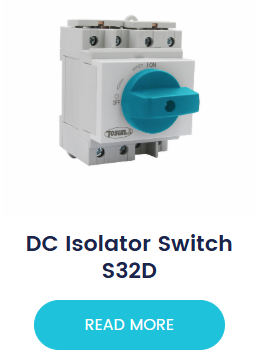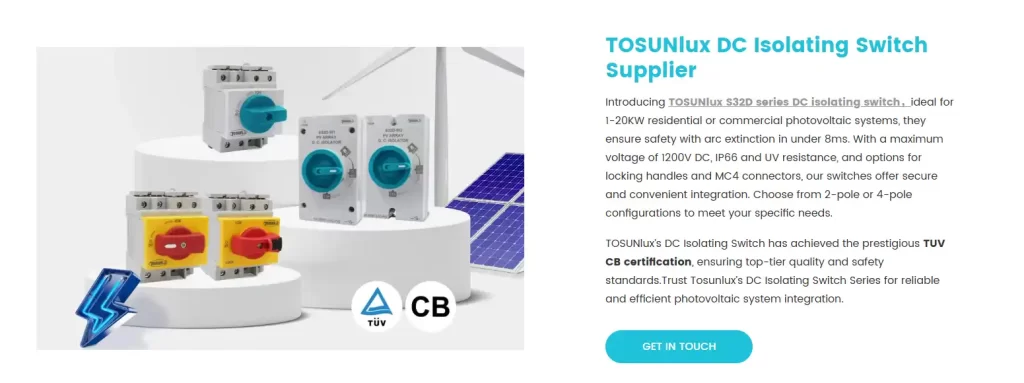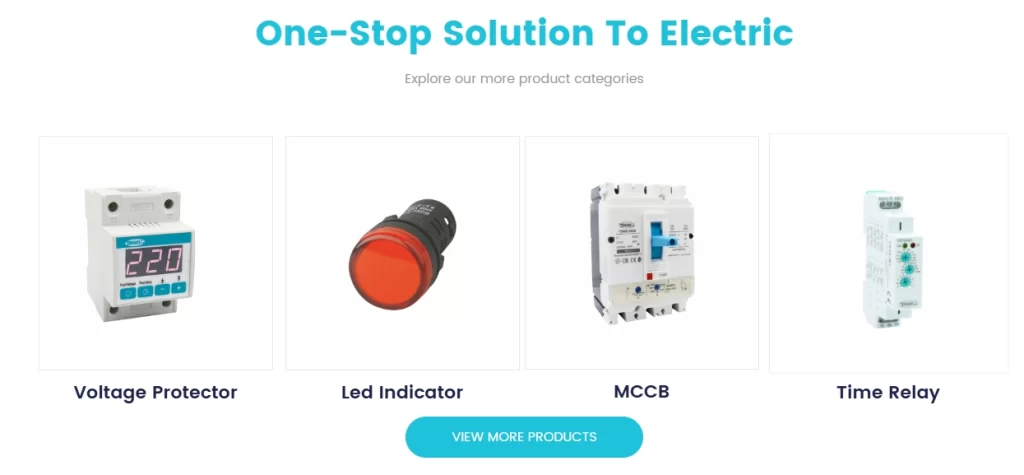สวิตช์แยก 3 ขั้วเทียบกับ 4 ขั้ว: เมื่อใดและอย่างไรจึงควรใช้แต่ละชนิด
สารบัญ
สลับ3 ขั้ว สวิตช์แยก ตัดการเชื่อมต่อตัวนำไฟฟ้าสามตัวใน สามเฟส ระบบ สวิตช์แยก 4 ขั้วก็ทำหน้าที่เดียวกัน แต่มีสายกลาง ซึ่งเพิ่มความปลอดภัยให้กับทั้งบุคลากรและอุปกรณ์สำคัญ หากโครงการของคุณต้องการการแยกวงจรอย่างสมบูรณ์ สวิตช์แยก 4 ขั้วเป็นตัวเลือกที่ปลอดภัยและครอบคลุมมากกว่า

ในคู่มือนี้ เราจะอธิบายความแตกต่าง สถานการณ์การใช้งาน พื้นฐานการเดินสาย และประโยชน์ของสวิตช์ทั้งสองประเภท นอกจากนี้ คุณจะได้เรียนรู้ว่าเหตุใดสวิตช์ไอโซเลเตอร์แบบ 4 ขั้วจึงไม่เพียงแต่เป็นที่นิยม แต่ยังจำเป็นอีกด้วย ไม่ว่าคุณจะบริหารจัดการอุปกรณ์อุตสาหกรรมหรือระบบ PV พลังงานแสงอาทิตย์ การเลือกสวิตช์ที่เหมาะสมจะช่วยเพิ่มความปลอดภัย การปฏิบัติตามข้อกำหนด และประสิทธิภาพ
ทำความเข้าใจพื้นฐาน: สวิตช์ไอโซเลเตอร์ 4 ขั้วคืออะไร?
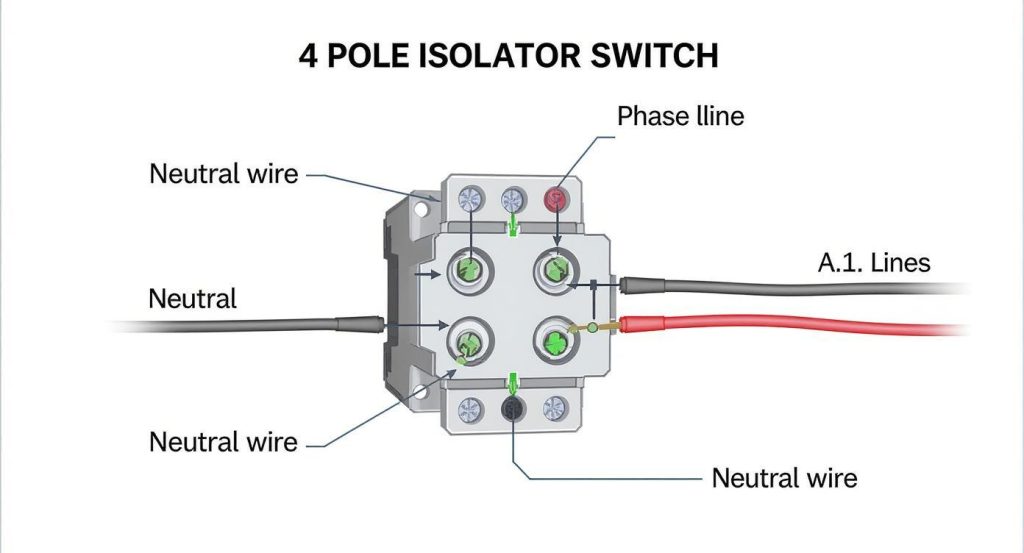
สวิตช์ตัดวงจรไฟฟ้าแบบ 4 ขั้ว (4-pole isolator) คืออุปกรณ์ตัดวงจรไฟฟ้าที่ตัดวงจรตัวนำไฟฟ้า 4 เส้นพร้อมกัน ซึ่งโดยทั่วไปคือสายไฟฟ้าที่มีกระแสไฟฟ้า 3 เส้น (R, Y, B) และสายนิวตรอน 1 เส้น สวิตช์ตัดวงจรไฟฟ้าประเภทนี้ออกแบบมาสำหรับระบบที่จำเป็นต้องตัดวงจรนิวตรอนและเฟสต่างๆ เช่น ในระบบสายดิน TN-CS หรือระบบโซลาร์เซลล์
สวิตช์ไอโซเลเตอร์ 4 ขั้วคืออะไร?

- ตัดการเชื่อมต่อทั้งสามเฟสรวมทั้งสายกลางเพื่อแยกวงจรทั้งหมด
- ช่วยเพิ่มความปลอดภัยโดยให้แน่ใจว่าไม่มีกระแสไฟฟ้าไหลกลับผ่านสายกลางระหว่างการบำรุงรักษา
- มีความจำเป็นสำหรับการใช้งาน เช่น พลังงานแสงอาทิตย์ การต่อเครื่องกำเนิดไฟฟ้า หรือระบบที่มีโหลดผันผวน
การเปรียบเทียบสวิตช์ไอโซเลเตอร์ 3 ขั้วและ 4 ขั้ว
| คุณสมบัติ | สวิตช์แยก 3 ขั้ว | สวิตช์แยก 4 ขั้ว |
| จำนวนตัวนำไฟฟ้า | 3 (เฟส R, Y, B) | 4 (เฟส R, Y, B + นิวทรัล) |
| การแยกเป็นกลาง | ไม่รวม | รวมอยู่ด้วย |
| การใช้งานแอปพลิเคชัน | โหลดมาตรฐาน 3 เฟส | โหลดวิกฤต ระบบพลังงานแสงอาทิตย์ และเครื่องกำเนิดไฟฟ้า |
| ระดับความปลอดภัย | ปานกลาง | สูง (ตัดการเชื่อมต่ออย่างสมบูรณ์) |
| ข้อกำหนดการปฏิบัติตาม | พื้นฐาน | มักจำเป็นสำหรับแอปพลิเคชันที่ผูกกับกริด |
เมื่อใดจึงควรใช้สวิตช์ไอโซเลเตอร์ 3 ขั้ว
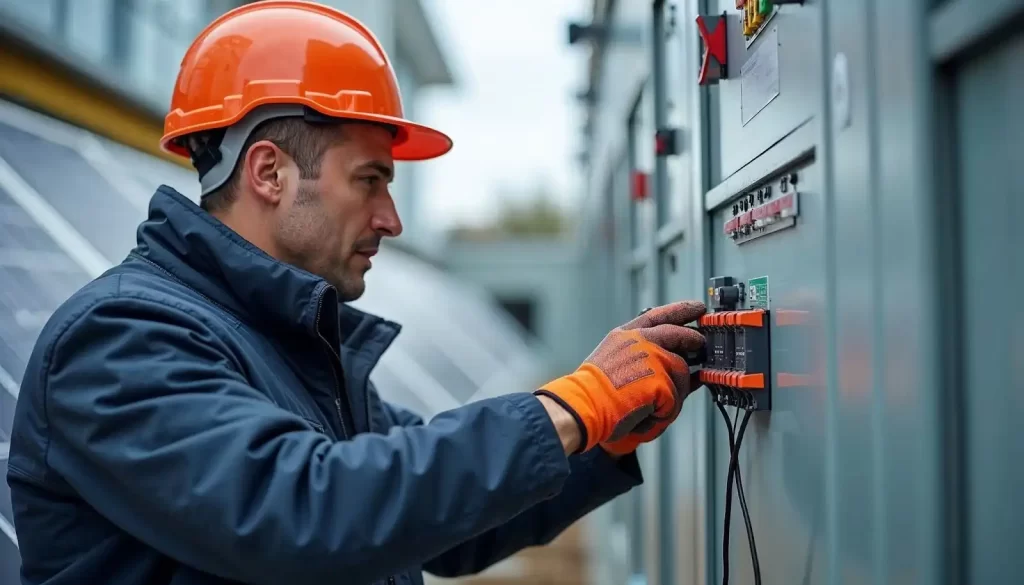
สวิตช์แยก 3 ขั้วเหมาะอย่างยิ่งสำหรับระบบสามเฟสมาตรฐานที่ไม่จำเป็นต้องใช้การแยกนิวทรัล มักใช้ใน:
- มอเตอร์อุตสาหกรรม
- ระบบปรับอากาศและระบายอากาศ
- ปั๊มน้ำ
- เครื่องมือกล
สวิตช์เหล่านี้เพียงพอเมื่อสายกลางถูกต่อลงกราวด์ที่อื่นหรือไม่สามารถส่งกระแสไฟฟ้าภายใต้สภาวะผิดพลาด
เมื่อใดจึงควรใช้สวิตช์ไอโซเลเตอร์ 4 ขั้ว
ใช้สวิตช์แยก 4 ขั้วเมื่อจำเป็นต้องตัดการเชื่อมต่อสายกลาง ซึ่งรวมถึง:
- ระบบโซล่าเซลล์ PV: เพื่อแยกทั้งสอง กระแสตรงและกระแสสลับ ด้านที่มีจุดเป็นกลางเพื่อการบำรุงรักษาที่ปลอดภัย
- ระบบเครื่องกำเนิดไฟฟ้า: เมื่อทำการสลับระหว่างกริดและเครื่องกำเนิดไฟฟ้าเพื่อป้องกันการป้อนกลับหรือการลอยตัวเป็นกลาง
- โหลดที่ละเอียดอ่อน: ในศูนย์ข้อมูลหรือสถานพยาบาล ความผันผวนที่เป็นกลางสามารถสร้างความเสียหายให้กับอุปกรณ์ได้
- ระบบ TT หรือ TN-CS: โดยต้องตัดสายไฟทั้งหมด รวมถึงสายกลาง เพื่อให้เป็นไปตามข้อกำหนด
ทำความเข้าใจแผนผังการเดินสายสวิตช์ไอโซเลเตอร์ 4 ขั้ว
แผนผังการเดินสายสวิตช์แยก 4 ขั้วโดยทั่วไปประกอบด้วย:
- อินพุตสามเฟส (R, Y, B)
- อินพุตเป็นกลาง (N)
- ขั้วต่อโหลดขาออก (เชื่อมต่อแบบอินไลน์)
แต่ละขั้วจะเชื่อมต่อกับตัวนำไฟฟ้าหนึ่งตัว และทุกขั้วเชื่อมต่อกันทางกลไกเพื่อทำงานร่วมกัน เมื่อปิดสวิตช์ สายไฟฟ้าทั้งสี่เส้นจะแยกออกจากกันทางกายภาพ ซึ่งช่วยลดความเสี่ยงจากการสัมผัสไฟฟ้า โปรดอ่านคู่มือการติดตั้งและกฎหมายท้องถิ่นทุกครั้งเมื่อเดินสายไฟ
ประโยชน์ของการใช้สวิตช์ไอโซเลเตอร์ 4 ขั้ว
การเปลี่ยนไปใช้สวิตช์แยก 4 ขั้วให้ประโยชน์มากกว่าแค่การปฏิบัติตามเท่านั้น:
- เพิ่มความปลอดภัย: ป้องกันกระแสไฟตกค้างหรือรั่วไหลไหลผ่านสายกลาง
- การป้องกันที่ได้รับการปรับปรุง: ความผิดพลาดของสายกลางอาจทำให้เกิดความเสียหายร้ายแรงต่ออุปกรณ์ได้หากไม่ได้ตัดการเชื่อมต่อ
- ความเข้ากันได้ของระบบ: ทำงานได้ดีกับระบบสายดิน TN-CS และ TT ที่ต้องตัดการเชื่อมต่อทั้งหมด
- ความอเนกประสงค์: เหมาะสำหรับการใช้งานที่หลากหลาย รวมถึงเครื่องกำเนิดไฟฟ้าสำรอง พลังงานแสงอาทิตย์ การชาร์จรถยนต์ไฟฟ้า สถานีและอื่นๆอีกมากมาย
ข้อผิดพลาดทั่วไปที่ควรหลีกเลี่ยงเมื่อเลือกใช้ไอโซเลเตอร์

- การละเลยความเป็นกลาง: ในระบบที่มีจุดเป็นกลางร่วมกัน การใช้ตัวแยก 3 ขั้วเพียงอย่างเดียวอาจทำให้วงจรมีพลังงานเพียงบางส่วน
- คะแนนไม่ถูกต้อง: ตรวจสอบให้แน่ใจเสมอว่ากระแสและแรงดันไฟฟ้าของสวิตช์แยกเหมาะกับการใช้งานของคุณ
- คุณภาพต่ำ: หลีกเลี่ยงสวิตช์ที่ไม่ได้รับการรับรอง สวิตช์ที่ไม่มีการรับรองที่เหมาะสมอาจเสี่ยงต่อไฟฟ้าขัดข้องหรือเกิดเพลิงไหม้ได้
TOSUNlux ช่วยให้คุณเลือกสิ่งที่ถูกต้องได้อย่างไร
ค้นหาโซลูชันของคุณด้วย TOSUNlux ไม่ว่าโครงการของคุณจะต้องการสวิตช์แยกแบบ 3 ขั้วที่ทนทาน หรือสวิตช์แยกแบบ 4 ขั้วที่มีความปลอดภัยสูง TOSUNlux ก็มีโซลูชันประสิทธิภาพสูงที่ได้รับการรับรองอย่างครบถ้วน ด้วยความเชี่ยวชาญระดับโลกกว่า 30 ปี TOSUNlux รับประกันว่าสวิตช์แยกที่เชื่อถือได้สำหรับ:
- พลัง แผงจ่ายไฟ
- ระบบโซลาร์เซลล์พีวี
- ระบบอัตโนมัติทางอุตสาหกรรม
- การประยุกต์ใช้ด้านการเกษตร
สำรวจเพิ่มเติมเกี่ยวกับสวิตช์ไอโซเลเตอร์ที่นี่:
คำถามที่พบบ่อย
สวิตช์ไอโซเลเตอร์ 4 ขั้วคืออะไร?
สวิตช์แยก 4 ขั้วเป็นสวิตช์ไฟฟ้าที่ตัดการเชื่อมต่อสายสามเฟสและสายกลางพร้อมกันเพื่อการแยกอย่างสมบูรณ์และปลอดภัย
ฉันควรใช้สวิตช์แยก 4 ขั้วเมื่อใด?
ใช้เมื่อจำเป็นต้องตัดการเชื่อมต่อสายกลาง เช่น ในระบบเครื่องกำเนิดไฟฟ้า ระบบ PV พลังงานแสงอาทิตย์ หรือวงจรอุปกรณ์ที่มีความละเอียดอ่อน
สวิตช์แยก 3 ขั้วเพียงพอสำหรับการใช้งานในอุตสาหกรรมส่วนใหญ่หรือไม่?
ใช่ หากการแยกกลางไม่ใช่สิ่งสำคัญ สวิตช์แยก 3 ขั้วมักใช้ในมอเตอร์และระบบ HVAC
ไอโซเลเตอร์ 4 ขั้วช่วยเพิ่มความปลอดภัยได้อย่างไร?
มันจะตัดการเชื่อมต่อสายกลางเพื่อป้องกันกระแสไฟรั่วที่ไม่คาดคิด ซึ่งจะช่วยลดความเสี่ยงของไฟดูดและความเสียหายของอุปกรณ์
ฉันจะหาแผนผังการเดินสายสวิตช์ไอโซเลเตอร์ 4 ขั้วได้ที่ไหน
ผู้ผลิตส่วนใหญ่มีคู่มือผลิตภัณฑ์ให้มาด้วย คุณยังสามารถดูตัวอย่างเลย์เอาต์ได้ในฟอรัมอุตสาหกรรมหรือผ่านแหล่งข้อมูล TOSUNlux
บทสรุป
การเลือกสวิตช์แยกที่เหมาะสมไม่ใช่แค่การปฏิบัติตามข้อกำหนดเท่านั้น แต่ยังรวมถึงการรับรองความปลอดภัยและความน่าเชื่อถือของระบบไฟฟ้าทั้งหมดของคุณด้วย สวิตช์แยกแบบ 3 ขั้วเหมาะสำหรับการใช้งานสามเฟสพื้นฐาน แต่สวิตช์แยกแบบ 4 ขั้วจะยกระดับความปลอดภัยขึ้นไปอีกขั้น จึงเหมาะอย่างยิ่งสำหรับการใช้งานที่สำคัญหรือการใช้งานกลางแจ้ง
จดจำ, โตซันลักซ์ พร้อมให้บริการสนับสนุนความต้องการของคุณทั่วโลก ค้นหาโซลูชันที่ได้รับการรับรองเพื่อรักษาความปลอดภัยให้กับระบบของคุณ ไม่ว่าคุณจะทำงานกับเครื่องจักรอุตสาหกรรมหรือการติดตั้งกลางแจ้ง
โทรศัพท์: +86-577-88671000
อีเมล: ซีอีโอ@tosun.com
Skype: tosunelectric
วีแชท: +86-139 6881 9286
วอตส์แอป: +86-139 0587 7291
ที่อยู่: ห้องเลขที่ 1001 Wenzhou Fortune Center,Station Road, Wenzhou, China
ขอใบเสนอราคา
ติดต่อเราผ่าน WhatsApp
 : +86-139 0587 7291
: +86-139 0587 7291 ภาษาอังกฤษ
ภาษาอังกฤษ ภาษาสเปน
ภาษาสเปน รัสเซีย
รัสเซีย ภาษาฝรั่งเศส
ภาษาฝรั่งเศส อาหรับ
อาหรับ ภาษาโปรตุเกสของบราซิล
ภาษาโปรตุเกสของบราซิล อังการา
อังการา ตุรกี
ตุรกี โปแลนด์
โปแลนด์ เนเธอร์แลนด์
เนเธอร์แลนด์ อิตาลี
อิตาลี ภาษาอินโดนีเซีย
ภาษาอินโดนีเซีย ฮินดี
ฮินดี อัลดู
อัลดู อัมเบรลล่า
อัมเบรลล่า เชสเชียร์
เชสเชียร์ ภาษาไทย
ภาษาไทย มงโกล
มงโกล วาร์ซี
วาร์ซี ชคิป
ชคิป เอลลิก้า
เอลลิก้า
